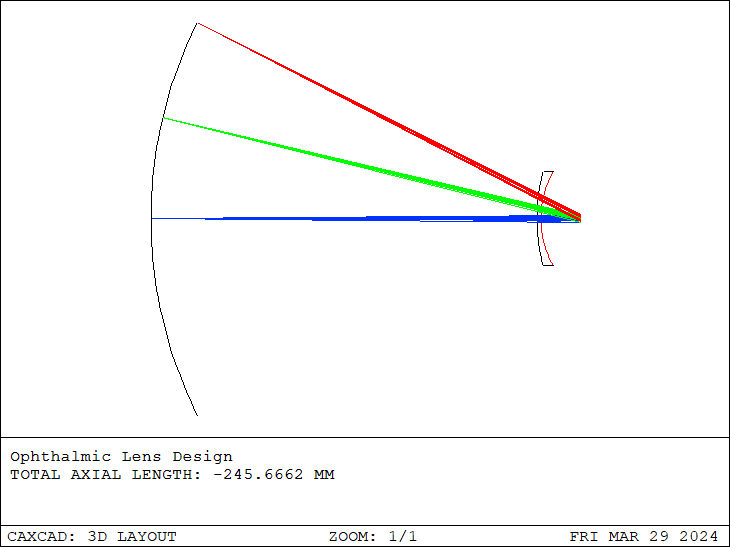Using CAXCAD for eyeglass lens design is straightforward. Although progressive lens design is not covered in this article, it's worth noting that progressive lenses typically adhere to the basic curve design principles of other eyeglass lenses.

Historically, eyeglass lens design focused primarily on controlling primary oblique astigmatism. Spherical aberration and coma were considered secondary, given the relatively small pupil size, with coma increasing linearly with field angle while astigmatism increases quadratically. Other aberrations were often ignored since they were not characteristic of the specific lens type. However, with the advancement of freeform manufacturing technology, lens manufacturers have been able to break away from these restrictive assumptions. Coupled with CAXCAD's ability to simulate various optical parameters, eyeglass lens design can be approached differently.
In the past, eyeglass lens design primarily focused on controlling primary oblique astigmatism. It was generally accepted that spherical aberration and coma were of lesser importance due to the relatively small pupil size and the linear increase of coma with field angle compared to the quadratic increase of astigmatism. Other aberrations were often disregarded as they were not characteristic of the specific lens type. However, the advent of freeform manufacturing technology has allowed lens manufacturers to break away from these restrictive assumptions. With the ability of CAXCAD to simulate various optical parameters, eyeglass lens design can be approached differently.
In this article, we mainly focus on the optical system design of regular eyeglass lenses, including nearsighted and farsighted lenses. First, let's establish the basic structural model for lens design, which is essentially a single lens design. More advanced lenses may incorporate non-spherical surfaces for optimization. The methods and principles of optimization and design are equivalent.
Nearsighted Lens Design
Nearsighted lenses are used to correct myopia (nearsightedness) by appropriately designing concave lenses, allowing distant objects to be seen clearly. Nearsighted lenses focus light in front of the retina, thus correcting the visual issues associated with myopia and enabling patients to see distant objects clearly.
The structural data of eyeglass lenses are straightforward, with convex surfaces for curvature radii around 110. The lens diameter is typically 60mm, and subsequent lens shapes can be ground according to different frame fittings at optical stores.

For a lens with a myopia of 300 diopters, we can directly adjust the curvature radius on the second surface. The focal power is solved by inputting -0.003.

The final surface of the optical system can be solved near the axis to determine that the virtual image of infinity is presented at the distance from the lens to the eye's center of rotation.

A simple numerical image analysis of this lens will show that the image quality in the central region of the eye is excellent, which is the primary requirement of the visual optical system. However, there may be significant chromatic aberration at the edges.

For this virtual image, which is equivalent to the object observed by the human eye, we need to ensure that the central resolution of the optical system can distinguish every 7-8 line pairs per millimeter.

Farsighted Lens - Reading Glasses
Farsighted lenses are typically used to correct hyperopia (farsightedness), allowing distant objects to be seen clearly. Reading glasses, on the other hand, are used to correct presbyopia (age-related farsightedness), enabling clear vision of nearby objects, especially for reading and close-up work.

Farsighted lenses are equivalent to convex lenses, so adjustments need to be made to the central thickness to ensure reasonable edge thickness.

Here we adopt the calculation of the lens edge thickness.

Upon completion of the farsighted lens design, the appearance is as follows:

Simple Discussion on Lens Materials
The materials catalog file OPHTHALMIC for common eyeglass lens materials is included in the CAXCAD software.
The MISC catalog also includes materials ACRYLIC, PMMA, and STYRENE, which are useful for contact lens and intraocular lens optics.

